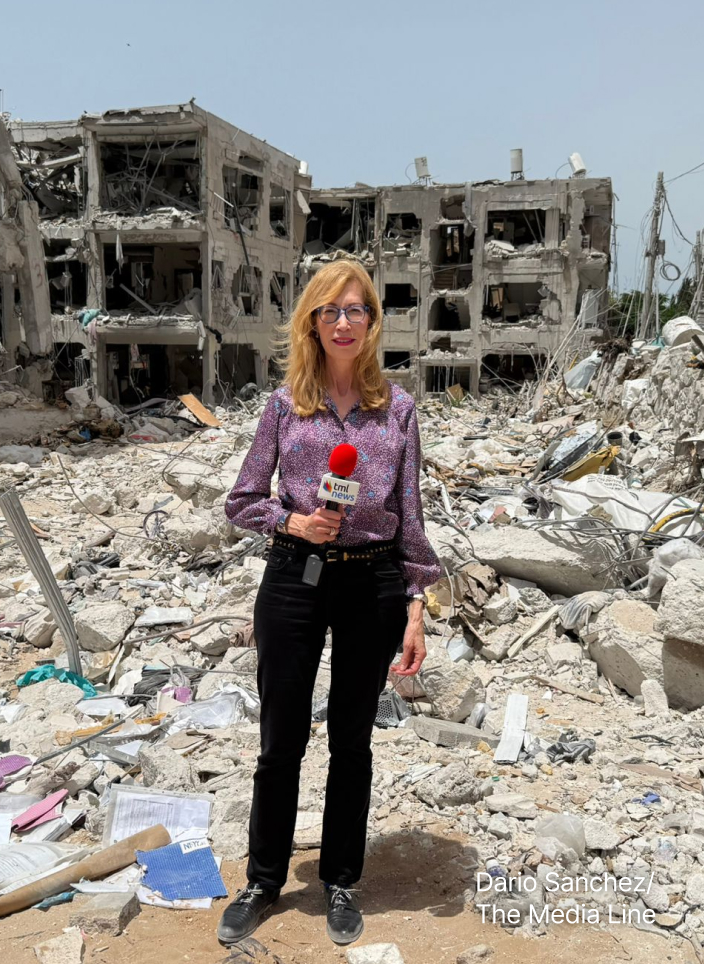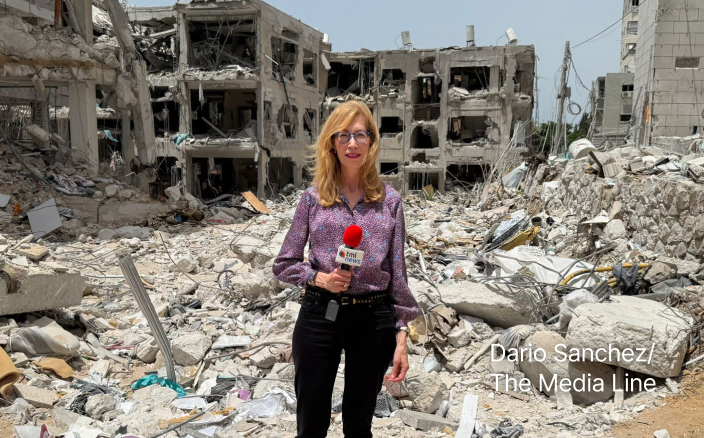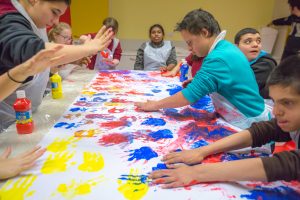Art as a platform of expression for those with special needs
Chana Goldstock lives in Jerusalem with her six children, two of whom have Down syndrome. Suri is one of them. Focused, agreeable, methodical and a proficient embroiderer, the 26-year-old is constantly sewing, drawing and painting, according to her mom.
Chana watched her daughter grow as an artist. She was spending hours each day embroidering and decided that Suri needed to get involved in some type of art program where she could cultivate and foster her love of art in an environment where someone would be able to guide her. So, Chana found the Friendship Circle.
With branches all over the world, the Friendship Circle was founded in Jerusalem in 2008 by Chanie Canterman, who saw a need for an organization to help immigrants from English-speaking countries, with children or family members with special needs, find a community. Similar to big brother or big sister programs, Friendship Circle pairs mostly teenage volunteers with someone with special needs, facilitating friendships.
“Friendship Circle brings friendship to those who need it most: children who look and feel different,” Canterman, who heads the Israeli branch of Friendship Circle, told The Media Line. “It’s filling in the circle that is missing with children with needs who are not always treated with love.”
“These children are lonely because they don’t really have friends,” Canterman added.
The organization offers a number of programs and activities to facilitate social inclusion, especially surrounding the Jewish holidays. Last year it unveiled a pilot program called “The Art of Friendship.”
Pairing seven Jerusalem-based artists, who volunteered, with 50 special-needs children, the program sought to create a space for children and young adults who have difficulties expressing themselves orally. Eventually, the students’ creations are auctioned off to raise money for Friendship Circle.
“Art has the power to transcend verbal and outer obstacles,” Canterman asserted.
Suri Goldstock, whose condition can cause physical and mental developmental delays, was paired with artist Andi Arnovitz, who told The Media Line “I had never worked with somebody with special needs, I didn’t know what to expect. In fact, she said, “I really fell in love with Suri.”
Once a week for about five months, Goldstock traveled, sometimes even alone, which is a feat in itself for someone with Down syndrome, to Arnovitz’s studio in the Baka neighborhood of Jerusalem. Never late and always with a smile on her face, Goldstock was open to trying anything Arnovitz suggested.
It was difficult, however, for Arnovitz to find an appropriate medium that would enable Goldstock to do the bulk of the work. She eventually landed on collaging.
Arnovitz described the system in a series of steps, stating that the finished pieces were about 70 percent Goldstock’s and 30 percent hers. “I devised a system of stencils, where she could trace and draw freely and where we could cut out what she had done and we could create these collages,” she said.
Goldstock painted on sheets of paper and then she and Arnovitz would place the stencils on the art and cut them out. Then they created scenes with the cutouts. Goldstock went with Arnovitz to pick out frames for her eight works of art prior to the auction in November.
Give the gift of hope
We practice what we preach:
accurate, fearless journalism. But we can't do it alone.
- On the ground in Gaza, Syria, Israel, Egypt, Pakistan, and more
- Our program trained more than 100 journalists
- Calling out fake news and reporting real facts
- On the ground in Gaza, Syria, Israel, Egypt, Pakistan, and more
- Our program trained more than 100 journalists
- Calling out fake news and reporting real facts
Join us.
Support The Media Line. Save democracy.


Stencil cut-outs of palm trees and leaves were painted in vivid colors and patterns and pasted onto black backgrounds with gold and black frames.
“She had incredible patience and focus, which is not a given for kids with special needs,” Arnovitz said. “She had a marvelous sense of color and she was so agreeable with a stick-to-it kind of attitude. I would definitely do this again.”
Chana has noticed a difference in her daughter, too.
“She grew as a person and she became much more independent – it helped her self-esteem and her pride,” Goldstock said.
A couple of months before Chana heard about the Art of Friendship project, she and Suri had called an art college in the Jerusalem area to inquire about their art programs for kids with special needs. They were told that the program did not take students like Suri, because they can’t keep up.
That’s how the mother and daughter duo got involved with the Art of Friendship.
The Art of Friendship is not the only program devoted to offering those with special needs a platform on which they can express themselves.
“People with disabilities can contribute something very important to the culture and to the arts,” Emmanuel Schen, the director of the Si’im Program at Shekel, an organization devoted to helping people with physical and mental disabilities, told The Media Line.
The Si’im Program, affiliated with Shekel, an NGO, is a project that tries to promote community involvement by enabling those with disabilities to participate in various music, theater, and art programs.
In one program, known as “Creating Contact: A Dialogue Through Art,” Schen and Si’im pair artists from Jerusalem’s Bezalel art academy with disabled students to create art together that is then exhibited in galleries.
“I noticed that people with disabilities can act and perform and do films and paint very impressively, so I started developing this as a way to give people a new aim in life,” Schen said.
The project, which has been ongoing for some 12 years, was exhibited in a small gallery called Barbur in the Nachla’ot neighborhood in Jerusalem. Featuring drawings, sculptures, a series of masks and even a decorated wheelchair, the art was the medium in which the artists could express themselves.
“They create together not as a teacher and a student but as participants,” Schen pointed out.
Vincent Van Gogh, Claude Monet, Pablo Picasso, Jackson Pollock. Even if you are not an art aficionado, you probably recognize all four of those names. What you may not know is that those artists, thought to be some of the most influential ever, had either documented physical or mental disabilities.
“There is the theory of having multiple kinds of intelligence,” Schen explained. “So, if you have an intellectual disability, it doesn’t mean that you don’t have other kinds of intelligence.”
According to the Central Bureau of Statistic and the Meyers-JDC-Brookdale Institute, about one million Israelis have some type of disability, with some eight percent of all children being disabled.
While the city and the country have been turning a new leaf in the special-needs world, the country still lacking in this sphere.
Miriam Avraham, co-founder of Shutaf, a Jerusalem-based organization that provides inclusion services to young people with disabilities says that things started changing in Jerusalem about five years ago, but the city still has a long way to go.
“There is a wind of change overall relating to inclusion, but it is really in its beginning stages,” Avraham told The Media Line.
The Knesset passed a law that requires any company with over 200 employees to employee at least six with documented disabilities. This law, however, is hardly enforced, according to Avraham. Tens of organizations like Friendship Circle exist in Jerusalem seeking to help those with disabilities – and even more exist in the country as a whole.
Art is a platform that many of these organization use as a means of offering special needs children and young adults the ability to be a part of a community while also creating something for the greater good. Making art gives them a sense of purpose.

Shalva, the Israel Association for Care and Inclusion of Persons with Disabilities provides a comprehensive range of services for thousands of individuals (from infancy to adulthood) and their families. “Art therapy is a staple component of Shalva’s rehabilitative and educational therapy programs for children with disabilities,” Kalman Samuels, Founder and Director of Shalva, told The Media Line. Nearly 400 children aged from one to 21 benefit from individual and group art therapy sessions at Shalva every week.
Shalva partners with the Bezalel Academy of Arts and Design in an inclusive program involving a series of joint instructional art sessions for Shalva’s children and Bezalel’s academy students. Through visiting Shalva and engaging with participating children, Bezalel’s students gain a unique understanding and appreciation for the power of art and inclusion.
“Art brings people together,” Ellie Klein, the spokesman for Aleh, an organization helping children and young adults suffering from intellectual and developmental disabilities, told The Media Line.
Aleh, has developed a shop, called the Aleh Boutique, where disabled artists can sell their work, with the funds all benefiting the program. The motto at Aleh is “Art as Therapy,” and, according to one of the teachers, Mery Aharon, the visual and creative art programs seek to empower, rehabilitate and advance those with special needs.
Art, and participating in the Art of Friendship auction, made Suri Goldstock feel like she had a job, and a greater purpose.
“This program was a defining moment in terms of what she wants to do with her life,” her mother Chana said. “It showed her that she has the potential and ability to do this.”